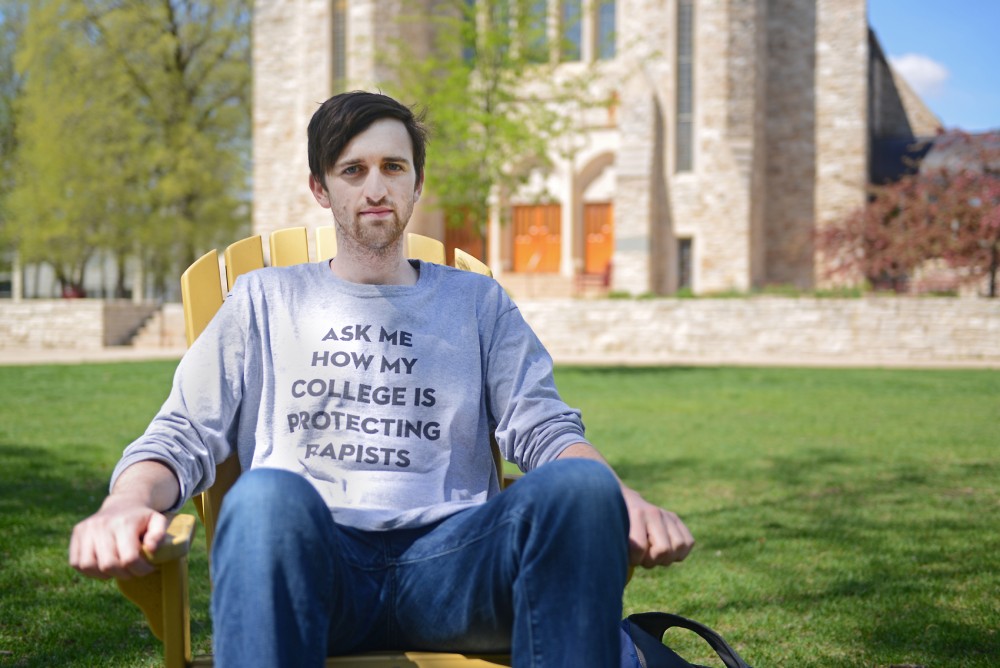Students at St. Olaf College have raised eyebrows and invited questions with gray T-shirts that state simply: “Ask me how my college is protecting rapists.”
The students started wearing the shirts last month, and their protest spawned a recent investigation of St. Olaf’s equality regulations as well as a discussion of rules across universities.
Madeline Wilson, a nursing senior at St. Olaf, was raped last May and reported it to administration in September.
Wilson said multiple administrators didn’t categorize her case as a rape even after she reported it three times.
She said she had the idea to wear the T-shirts in January out of frustration with her case’s investigation after the accused student was cleared.
“What if I just bare all of this?” she said. “I realized that I could have a dual purpose and also talk about some things at our college that we really needed to talk about.”
Wilson gathered a group of friends and other students with similar experiences to hers, said Wilson’s friend Steph Hagan, a philosophy and ancient studies senior at St. Olaf. Hagan said the process was trying for Wilson.
“It was horrendous,” she said. “First and foremost, you just feel very helpless. Every week it was just something new.”
She said some approached them and asked questions when the group first wore the shirts, but many didn’t want to engage. “Mostly, overwhelmingly, people just avoided us.”
Doug Carmody, an English and math senior at St. Olaf and Wilson’s friend, said he has been part of the gray shirt movement from the beginning.
Carmody said students who identify with Wilson’s story have shared her concerns with the school’s process.
“What we’ve noticed is, basically, if someone has a case, administration will be slow to find out who the perpetrator is,” he said. “They’re coming at things from such an administrative perspective.”
St. Olaf admin stalls further talks
St. Olaf was initially responsive to the group’s concerns and even set up a meeting a week after they first began the T-shirt campaign, Hagan said, but communication has since stalled.
“They have become not responsive whatsoever,” she said. “We have asked for meetings multiple times. … At this stage, it’s been pretty unprofessional.”
In response to the group’s demands, administrators started a group of experts to investigate the school’s federally mandated Title IX anti-discrimination policies.
Michael Kyle, St. Olaf’s vice president for enrollment and college relations, said he oversees the group.
“We wanted a group that included people from a wide range of backgrounds,” Kyle said. “This is something that is important at the highest levels of college governance.”
The team has two students, a member of the school’s board of regents, experts with backgrounds in these types of disputes and a Title IX expert from Macalester College, he said.
Alongside the investigation, St. Olaf launched a website to field concerns and questions related to the school’s Title IX policy, Kyle said.
He said all colleges and universities operate within certain parameters, but each has its own discretion. “There are different ways to interpret certain elements of federal policy,” Kyle said.
The working group — which first met last month and will meet each week through June — will review this interpretation of the law, Kyle said.
“[Those wearing the gray shirts] feel that our policy is either inadequate or that we did not follow the process that we feel honors the policy and requirement,” he said.
A concern across MN colleges
Different schools use unique models to interpret and implement Title IX, including the University of Minnesota, said Kimberly Hewitt, director of the University of Minnesota’s Office of Equal Opportunity and Affirmative Action.
The EOAA started investigating student-to-student sexual misconduct in 2014. Students can report any type of sexual, racial or gender discrimination for the office to investigate, Hewitt said.
While they aim to finish reports within 60 days, she said EOAA investigators often spend six weeks on the task.
“We are trying to really strategize ways to make it more efficient,” Hewitt said. “It’s a complex area, and I think most institutions are trying to analyze their processes.”
In the hearings that often follow the investigations, EOAA staff often hear that students want faster reports and appointments, she said.
“Protest is sometimes necessary,” Hewitt said. “I think that lots of people are impacted by the problem and want to see it addressed in the best way.”
Finding ways to handle the trauma
Katie Eichele, director of the University of Minnesota’s Aurora Center, helps students report sexual misconduct by giving them options on how to proceed, often arranging appointments with the EOAA.
“Victims and survivors sometimes get mixed messages,” Eichele said. “They’re encouraged to report, report, report. When they report, there’s an expectation that people know how to investigate.”
She said campus staff should know how to handle trauma. Because the University of Minnesota’s investigators have been educated in this area, she said they don’t see as many complaints from students.
This training is important to understanding the point of view of a victim-survivor, said Yvonne Cournoyer, prevention program manager for the Minnesota Coalition Against Sexual Assault.
Cournoyer said MNCASA is organizing a campus sexual violence prevention summit this June and helped pass legislation last year to improve responses to sexual assault.
Cournoyer said she sees students getting involved if they aren’t content with how schools respond to sexual assault.
“I think we’re seeing a real culture shift on campuses in terms of understanding who’s responsible for sexual assault,” she said. “For a long time, the focus was on victims and what victims did or didn’t do.”

















